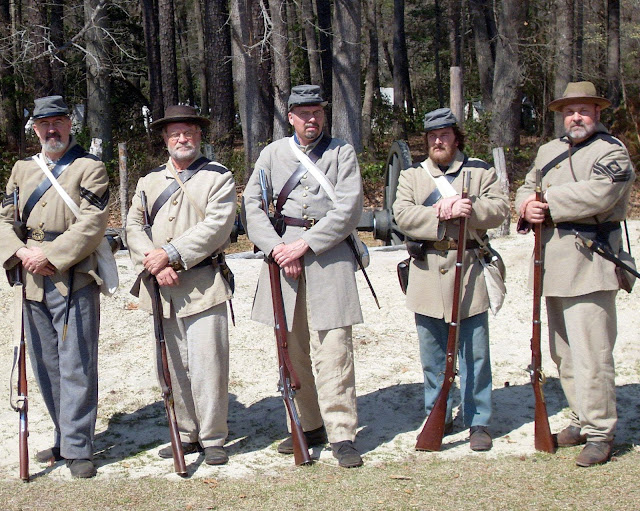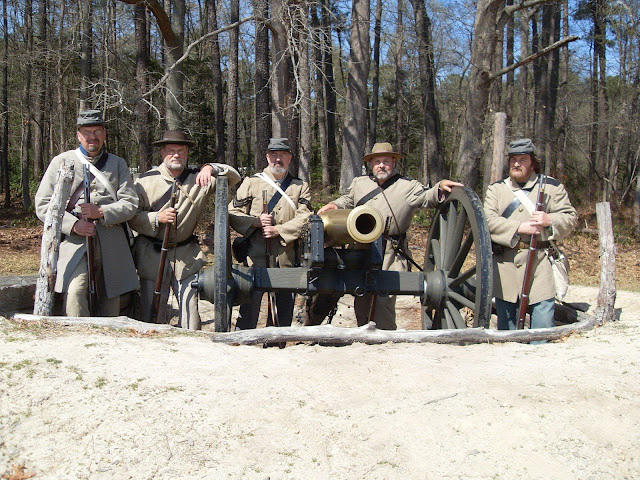 |
| 6th North Carolina State Troops at Bentonville March 11, 2011 |
Last Saturday (19 March 2011) I participated, with other members of the 6th North Carolina State Troops, in a living history program at the Bentonville Battlefield State Historic Site as part of their Civil War Sesquicentennial commemoration. The program was called "TO ARMS! TO ARMS" and featured us reenactors portraying civilians answering the call to duty, to be recruited into the Confederate Army. My previous post describes my experience being recruited. This post will describe what it was like to learn drill for the first time. For this program, the reenactors were instructed to "forget everything" we knew about drilling and pretend we didn't know a thing...not too hard for most of us after a long, idle winter off the drill field.
After taking the oath of allegiance to the Confederate government and then being sworn into Confederate Service, uniformed officers pushed and prodded us into a line facing a mean faced drill sergeant.
"OK. you ignorant sod-busters, shut up and pay attention!"
I was getting the feeling the honeymoon was over...
"How many of you dumb farm boys know your right from your left?"
A scattering of hands were sheepishly raised.
"This is your right" said the Sergeant, like he was talking to a group of dimwitted school children.
Facing the men, he pointing to the right with his right hand. This was instantly mimicked by a several of the recruits who pointed in the same direction, the mirror image of the sergeant, which of course was their left hand.
"No you idiots! that is your left hand " roared the Sergeant to the delight of the spectators.
Looking confused, recruits started turning around in circles, pointing every which way and babbling to each other about which is right and which is left. The Sergeant was clearly losing control.
"Quiet in the ranks! Get back in line! Now pay attention."
He walked up to a recruit in the center and, roughly grabbing him by the shoulder, spun him to the right.
"This is right face!"
Now he spun him 180 degrees to the left, "This is left Face!"
Glaring at the recruits he shouted "Got it? GOOD! Now you try it!"
"Right FACE"
Most of the recruits turned right, but a few turned left.
"Your other right!" screamed the Sergeant spinning a lefty to the right position.
"Now, come back where you started when I say front."
"FRONT!"
Most of the recruits turned back to face him, but a few of us had the same idea to mess things up, so we faced backwards.
"Front...FRONT....FRONTTTTT!" screamed the exasperated sergeant trying to get our attention.
We ran through our "facings" several more times, demonstrating to the crowd how challenging it was for the sergeant to get all the men to follow the same command. Being quick learners, we soon had these simple commands committed to memory.
It was said that farm boys joining the army often didn't know their right foot from their left foot. Maybe this knowledge wasn't important in farming, but it is critical in the army. The drill sergeants quickly realized that the farm boys knew the difference between hay and straw, so by sticking some hay into the laces of one boot (called brogans) and straw in the other, the sergeant could call the cadence of "Hay foot , Straw foot" instead of "Left, Right, Left."
We didn't suffer the indignity of shoving straw in our shoes, but the event narrator told this story to the spectators. Is it true? Who knows, but it is an entertaining story.
Now that we had learned our left from our right, it was time to engage in musket drill and the sergeant attemped to lead us across the street to the drill field. Spectators trailed along as if following the pied piper. We were marching in single file, but like so many kindergartners on a lovely spring day we soon bunched up and started chatting amongst ourselves as we lolly-gagged in the general direction the sergeant was headed.
The poor sergeant was nearly apoplectic when he turned and saw what a disorderly mess his single file line had become.
"What are you men doing? Get back into Line! Single file there! Quiet in the ranks!"
He soon marshaled us into a line again and we arrived at our destination. As the Spectators gathered to watch, He ordered us to re-line up by height. Playing the dumb recruits, we wandered around in confusion in disorder before the NCO's and officers got us lined up properly.
The Sergeant explained the difference between a rank (all the men in either the front or rear line) and a file (each pair of men, one in the front rank and one in the rear rank). Next he gave the order: "In each rank Count TWO's"
Trained recruits would replay "One, Two, One, Two, One, Two" and so on, down the line. But we we're trained recruits....
"One, Two, Three..."
"Hold on!" said the Sergeant "There is only ONE and TWO! There is no three!
"Yes there IS!" someone yelled out, "it comes after two, they taught us that in school"
"QUIET IN THE RANKS" Screamed an onlooking officer
"You don't have to shout..." Said another voice from the ranks
"ONE!, TWO!, ONE!, TWO!, ONE!, TWO!" shouted the sergeant as he walked down the line poking an index finger into the chest of each front rank man in turn.
"Now you try it!"
The recruits has some more fun pretending to be confused and messing up this simple count, drawing chuckles from the onlooking spectators. By this time even the dullest of the spectators understood this better than if we had tried to explain it to them.
Once we were finally counted off, we learned how to form a column of four, again with much pretended difficulty and confusion, to the consternation of the officers. The recruits complained about the heat. They complained because their feet hurt. They complained because the musket was heavy. Sometimes when an order was given, a voice would mutter "who voted him to be the boss anyway!"
At one point an officer disgustedly shouted, "You men are hopeless! this line looks terrible! You should come here and see how bad you look!"
Half the men in the front rank took his invitation at face value and rushed toward where he was standing to have a look.
As the crowd roared in laughter, the officer sputtered "What are you men doing? Get back in line!"
The men slunk back to their places and several of them were heard to mutter "well he said to come take a look!".
All the reenactors played their parts well. The officers and NCOs were properly stern and demanding. The raw recruits were...well...raw and clueless. But, now it was time to show the crowd what we really knew. We told the crowd to fast forward six months into the future after we had been properly trained and, with the reenactors on their best behavior, we ran though the facings and manual of arms without flaw. We marched around the field in fine formation, fired a number of nearly perfect volleys and for the finale, we fixed bayonets and charged the crowd. Their applause told us they were impressed.
This program gave spectators a better understanding of what it took to drill raw recruits. Now it was their turn. Officers asked for volunteers. Young and old alike came forward to try mastering the skills that eluded us all morning. NCO's handed out wooden muskets. The new batch of "recruits" were lined up and counted off. They were about to discover the joys and pains of reenacting.
The rest of us broke ranks and headed to camp for lunch with a fresh appreciation for the skills we had mastered over the years.






